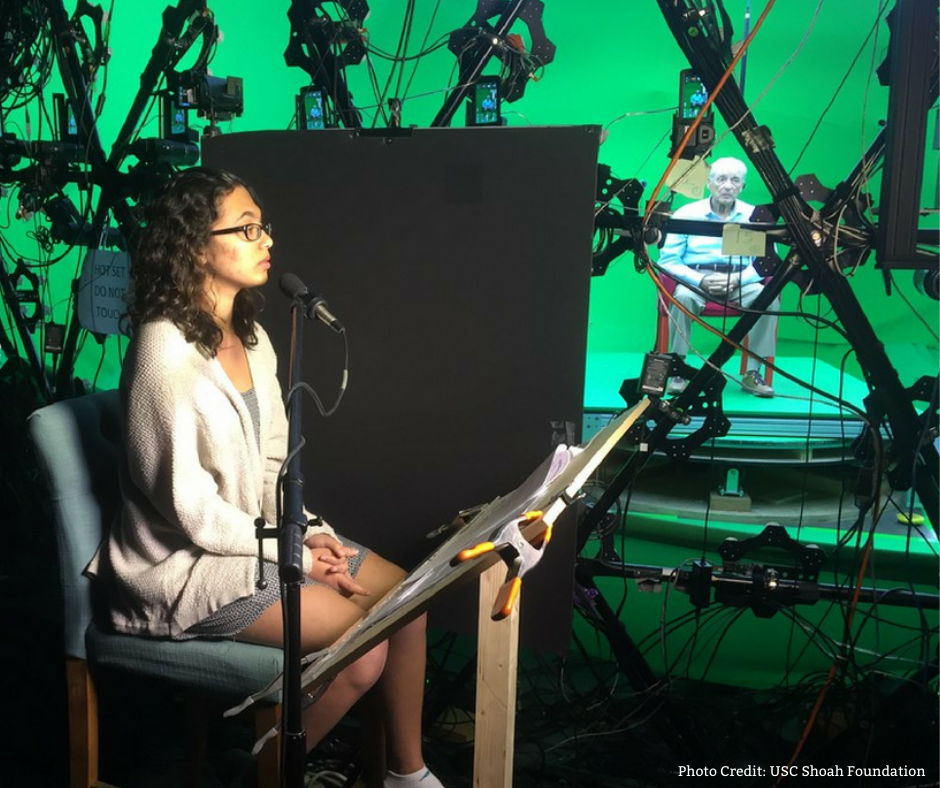Recent innovations in Holocaust education empower teachers to create memorable—even life-changing—pedagogies that were not conceivable a decade ago. Cutting-edge technologies offer powerful pathways to achieve key learning aims and outcomes, while grabbing the attention of students who crave new experiences in their learning. However, like all Holocaust education resources, these technologies require a conscientious touch and careful framing to maximize their learning potential and ensure students are prepared.
USC Shoah Foundation and Echoes & Reflections believe that pedagogical goals must come first—and that advances in technology should only be applied in service of considered educational outcomes. In genocide education—especially when working with personal stories entrusted to us by survivors—it is paramount that technology and innovation are only wielded to amplify a survivor’s message, and that they never distort or decontextualize the storytelling.
Keeping the above context in mind, below are several innovative resources available to Echoes & Reflections educators:
Newly available in IWitness, Dimensions in Testimony allows students and educators to ask questions that prompt real-time responses from a pre-recorded video of Holocaust survivor Pinchas Gutter—engaging in a virtual conversation from their own computers, and redefining what inquiry-based education can be. Through Dimensions in Testimony, it is possible to speak with survivors and witnesses of the Holocaust and other genocides from anywhere—and that possibility will remain in perpetuity.
Each student’s responses will be wholly unique because each student chooses and asks their own questions. As such, Dimensions in Testimony offers students an unprecedented degree of control over their learning—resulting in deep, empathetic engagement with subject matter.
The Willesden READS Program engages students through the story of Lisa Jura, who was rescued from the Holocaust in Vienna by the Kindertransport. This program has a rich history of in-person engagements: author, performer and virtuoso concert pianist Mona Golabek has shared her mother’s story on stage for over one million students around the world. But facing the COVID-19 pandemic, Mona partnered with Echoes & Reflections, USC Shoah Foundation and Discovery Education to transform the program into a livestreamed, remote event, thereby bringing Willesden READS to students and teachers in select cities across the United States in spite of the global health crisis.
Even before this new adaptation, the Willesden READS Program had always been a creative force on the cutting edge of Holocaust education. Fusing multiple media—the book, The Children of Willesden Lane, alongside the live performance and a series of learning engagements beyond.
The Echoes & Reflections interactive timeline—designed foremost for student use—chronicles key dates in the history of the Holocaust, spanning from 1933-1945. With the Timeline of the Holocaust, students explore history through the collective expertise and primary source archives of ADL, USC Shoah Foundation and Yad Vashem, who have constructed an approachable, tactile learning tool that centers on primary sources and individual experiences to ensure that the human impact of the Holocaust is never forgotten.
The Timeline of the Holocaust is designed to be flexible and meet the needs of educators across their curriculum. It can be a resource for students and educators to consult, or it can be the foundation of a multi-day research project.
4. We Share the Same Sky Podcast
Produced by USC Shoah Foundation and listed as one of HuffPost’s best podcasts of 2019, We Share The Same Sky brings the past into the present through a granddaughter’s decade-long journey to retrace her grandmother’s story of survival. We Share The Same Sky tells the two stories of these women—the grandmother, Hana, a refugee who remained one step ahead of the Nazis at every turn, and the granddaughter, host Rachael Cerrotti, on a search to retrace her grandmother’s story.
Experienced Holocaust educators at Echoes & Reflections and USC Shoah Foundation have built a series of bold educational resources to support this pioneering podcast which intimately confronts the Holocaust’s intergenerational impacts and explains what its legacy can tell us about our world today.
5. IWalk
USC Shoah Foundation’s first mobile application, IWalk (available in the App Store and Google Play), offers visitors and students curated tours that connect specific locations of memory with testimonies from survivors and witnesses of genocide, violence and mass atrocity. IWalks are carefully curated by USC Shoah Foundation’s team of educators and scholars who help contextualize and humanize the history at sites of memory through testimony, photographs, and maps.
Educators in the United States currently have access to a series of IWalks in Philadelphia, which create potent multimedia learning experiences for students, educators and community members who visit the Horwitz-Wasserman Holocaust Memorial Plaza.
So much more is on the horizon at Echoes & Reflections and USC Shoah Foundation, and we cannot wait to share. We have already arrived at the future of Holocaust education, and it’s ready for use in your classroom—today.
About the author: Greg Irwin is Head of Content Management on the Education team at USC Shoah Foundation – The Institute for Visual History and Education. He is the Institute’s partner lead for Echoes & Reflections, and manages both the Echoes & Reflections and IWitness websites, as well as the IWalk mobile application.





 English
English